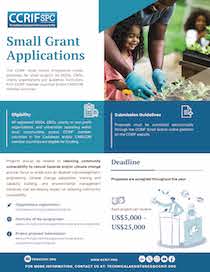Grand Cayman, Cayman Islands, June 22, 2020. CCRIF paid the Government of Guatemala approximately US$3.6 million under its excess rainfall (XSR) parametric insurance policy for nine days of rain that occurred during Tropical Storms Amanda and Cristobal. The policy was triggered by rains that started on May 31.
Amanda, which originated in the Pacific Ocean, initially made landfall on Guatemala’s Pacific coast on May 31, causing flooding and landslides. This tropical storm dissipated but the remnants reorganized to become Tropical Storm Cristobal, the third storm in the Atlantic Basin, on June 1 – a rare cross-over tropical cyclone with origins in the Pacific Basin. Amanda and Cristobal led to over a week of devastating rainfall across parts of Central America.
Guatemala became a member of CCRIF in 2019 and is receiving a payout within its first year of joining the Facility. This payment is being made under Guatemala’s policy for 2019/20. The new policy year started on June 1, 2020, for which Guatemala has renewed its excess rainfall coverage.
CCRIF currently has 22 member governments of which three are from Central America – Nicaragua, Panama, and Guatemala. Since its inception in 2007, CCRIF has made a total of 43 payouts for 21 events (earthquakes, tropical cyclones, and excess rainfall events) to 14 member governments totalling US$155.8 million. CCRIF’s payouts are made within 14 days of an event, allowing governments to begin to address their most pressing needs and close the liquidity gap.
In the 2019/20 policy year, CCRIF made five payouts as follows: two to The Bahamas totalling US$12.8 million following Hurricane Dorian, which battered the Abaco Islands and Grand Bahama in September 2019; one to Trinidad and Tobago totalling US$362,982 for its excess rainfall policy, which was triggered due to rainfall associated with Tropical Cyclone Karen in October 2019; one payout of US$203,136 to Belize also due to rains from Amanda and Cristobal; and the current payout to Guatemala.
These rapid payouts are possible because the insurance policies that CCRIF sells are parametric as opposed to indemnity insurance – otherwise referred to as traditional insurance. Parametric insurance products are insurance contracts that make payments based on the intensity of an event (for example, hurricane wind speed, earthquake intensity, or volume of rainfall) and the amount of loss calculated in a pre-agreed model caused by these events. Therefore, payouts can be made very quickly after a hazard event, as parametric insurance does not require an on-the-ground assessment of individual losses after an event before a payment can be made – a process that can take months for a claim to be settled.
CCRIF extends sympathies to the governments and people of Guatemala – and all Central American countries that were impacted by these events – for the loss of life and impacts on communities and livelihoods caused by these storms.
In 2015, CCRIF signed a Memorandum of Understanding with the Council of Ministers of Finance of Central America, Panama, and the Dominican Republic (COSEFIN) to enable Central American countries to join the Facility. Nicaragua was the first Central American country to join and has been a member of CCRIF since 2015. Since joining CCRIF, the Government of Nicaragua has received two payouts totalling US$1.6 million under its earthquake and tropical cyclone policies.
CCRIF provides parametric insurance coverage to the two regions – the Caribbean and Central America – through different segregated portfolios or cells. CCRIF aggregates disaster risks within the two regions but keep the risks segregated across regions, achieving the kind of risk diversification and spreading within each zone that members are not able to attain on their own and reducing costs by sharing operational services between both regions.
Empirical evidence based on studies undertaken by the World Bank illustrates that insurance obtained through CCRIF could be as low as half the cost of coverage a member country could obtain by approaching the reinsurance market on its own. The Facility provides parametric insurance policies for tropical cyclones, excess rainfall, earthquakes, and fisheries to 19 Caribbean and 3 Central American governments and is always encouraging new countries to join.
About CCRIF SPC:
CCRIF SPC is a segregated portfolio company, owned, operated and registered in the Caribbean. It limits the financial impact of catastrophic hurricanes, earthquakes and excess rainfall events to Caribbean and Central American governments by quickly providing short-term liquidity when a parametric insurance policy is triggered. It is the world’s first regional fund utilising parametric insurance, giving member governments the unique opportunity to purchase earthquake, hurricane and excess rainfall catastrophe coverage with lowest-possible pricing. CCRIF was developed under the technical leadership of the World Bank and with a grant from the Government of Japan. It was capitalized through contributions to a Multi-Donor Trust Fund (MDTF) by the Government of Canada, the European Union, the World Bank, the governments of the UK and France, the Caribbean Development Bank and the governments of Ireland and Bermuda, as well as through membership fees paid by participating governments.
In 2014, an MDTF was established by the World Bank to support the development of CCRIF SPC’s new products for current and potential members and facilitate the entry for Central American countries and additional Caribbean countries. The MDTF currently channels funds from various donors, including: Canada, through Global Affairs Canada; the United States, through the Department of the Treasury; the European Union, through the European Commission, and Germany, through the Federal Ministry for Economic Cooperation and Development and KfW. Additional financing has been provided by the Caribbean Development Bank, with resources provided by Mexico; the Government of Ireland; and the European Union through its Regional Resilience Building Facility managed by the Global Facility for Disaster Reduction and Recovery (GFDRR) and The World Bank.





